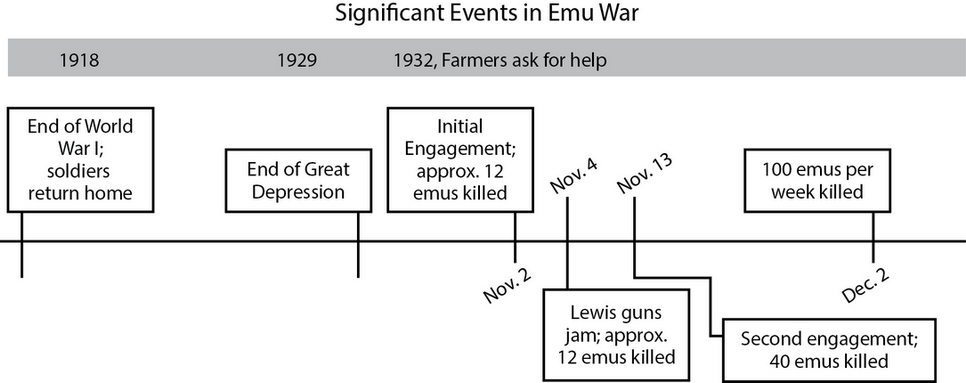PSAT Reading Practice Test 46: Social Science: The Emu War
Questions 1-10 refer to the following information.
The best-laid plans often have unexpected consequences. Popular among chaos
theorists, the butterfly effect refers to the interdependence of all events, and how even
seemingly trivial changes in any of these can cause disproportional differences in the
non-linear space-time continuum. Chances are that following World War I, when British
05veterans were encouraged by the government to farm wheat in Western Australia, they
had no idea they would be setting into motion another deadly conflict: The Great Emu
War of 1932.
The end of World War I had many positive effects on the world: the end of world violence,
the beginning of talks of worldwide peace organizations and treaties. However, there were
10also negative impacts. The end of the war also meant the end of many war-related jobs.
Additionally, thousands of soldiers were returning home to economies already unable to provide
enough employment opportunities to citizens. While different countries had different
solutions to the problem, in Australia the government encouraged British veterans to take up
farming. Subsidies were guaranteed but either failed to be provided, or weren't enough. As a
15result, by October 1932, wheat prices fell dangerously low.
Justifiably outraged, the farmers and government entered a time of rising tensions. Matters
were made appreciably worse when over 20,000 emus entered the scene. Emus follow predictable
migration patterns and when the farmers settled the land, the emus were residing in
the coastal regions. In October, they started their migration toward the warmer, inland areas
20of Australia. Due to the extensive farming that had taken place, the land had been cleared-
allowing easier migration-and there was a plentiful water supply from irrigation systems.
In essence, the emus had found a perfect habitat. They destroyed much of the underpriced
crop the farmers had painstakingly grown. This was the final straw for the farmers and they
demanded the government provide them military aid.
25The government assigned the emu mission to Major G.P.W. Meredith along with two soldiers
to assist him. Beginning in November, Major Meredith, the two soldiers, two Lewis guns,
and 10,000 rounds of ammunition arrived to "take care of" the emu problem. Similar to a
typical war involving humans on both sides, there were several "engagements" in this "war." A
variety of borderline comical events took place from the soldiers underestimating the emus'
30military prowess (they broke into several guerilla like groups), to the Lewis guns jamming,
to Major Meredith deciding to mount the guns on a military vehicle. In the end, the war was
an overall failure and Major Meredith and his men returned home with only a fraction of the
emu pelts they were supposed to have acquired.
The retreat of Major Meredith allowed the emus to return to the farmlands and once again
35ravage the crops. The farmers again called on the government for aid, and the Minister of
Defense approved another military engagement with the emus. Despite his previous failure,
Major Meredith was sent back to the field. Drawing on his previous experience, he was reportedly
much more successful this time around.
Following the "war," word travelled and eventually reached Great Britain. Several news-
40papers had comical responses to the so-called "Great Emu War." While it undoubtedly had
comedic threads, the emus did have a devastating effect on an already tenuous situation. A
bounty system was reinstated to avoid government involvement and potential future embarrassment
should they lose another "war" to these large, flightless birds. Despite this, the
farmers called again for government aid in 1934, 1943, and 1948. However, the bounty system
45ended up being much more effective as locals were more well equipped and knowledgeable
about hunting the emus than was the military.
